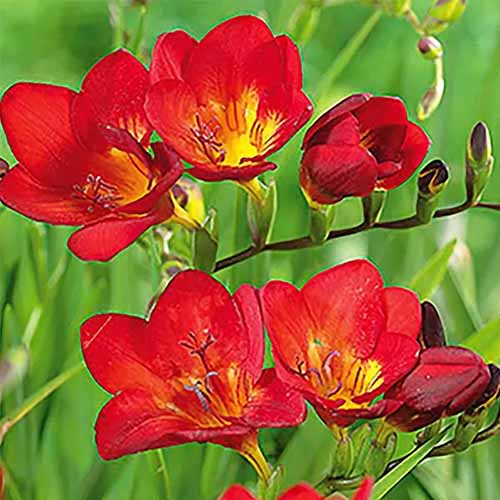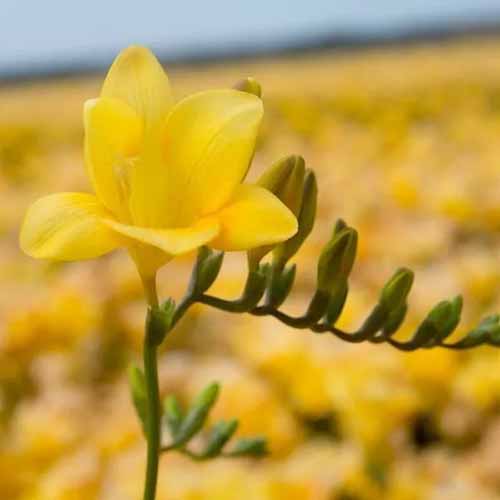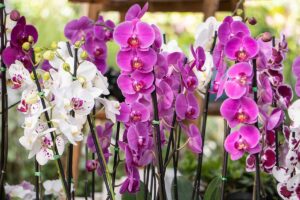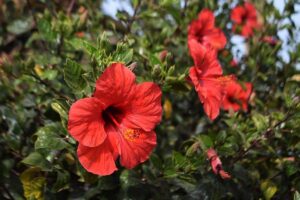Freesia spp.
Freesia is a genus of about 16 fragrant flowering species in the Iridaceae family that also includes gladiolus and iris.
The blossoms are showy, with three upper petals and three sepals below, forming a tubular or funnel-shaped vessel favored by honeybees.
Colors include a striking variety of lavender, orange, pink, purple, red, white, yellow, and bicolor combinations.

We link to vendors to help you find relevant products. If you buy from one of our links, we may earn a commission.
Those most readily available to today’s gardeners are hybrids. In Zones 9 to 10, they are perennials.
Elsewhere, they may be grown as annuals to be discarded at season’s end, tender perennials lifted before first frost and stored over the cold months, or grown indoors for winter blooms.
This guide discusses all you need to know to grow and care for freesia at your house.
Here’s what we’ll cover:
What You’ll Learn
Let’s start with a bit of background.
Cultivation and History
Cool-weather freesia grows from a bulb-like tuber called a corm and blooms from mid-winter to spring in its native South Africa, entering dormancy when the temperatures rise above 70°F.
It is winter hardy in Zones 9 and 10 but frost-tender.
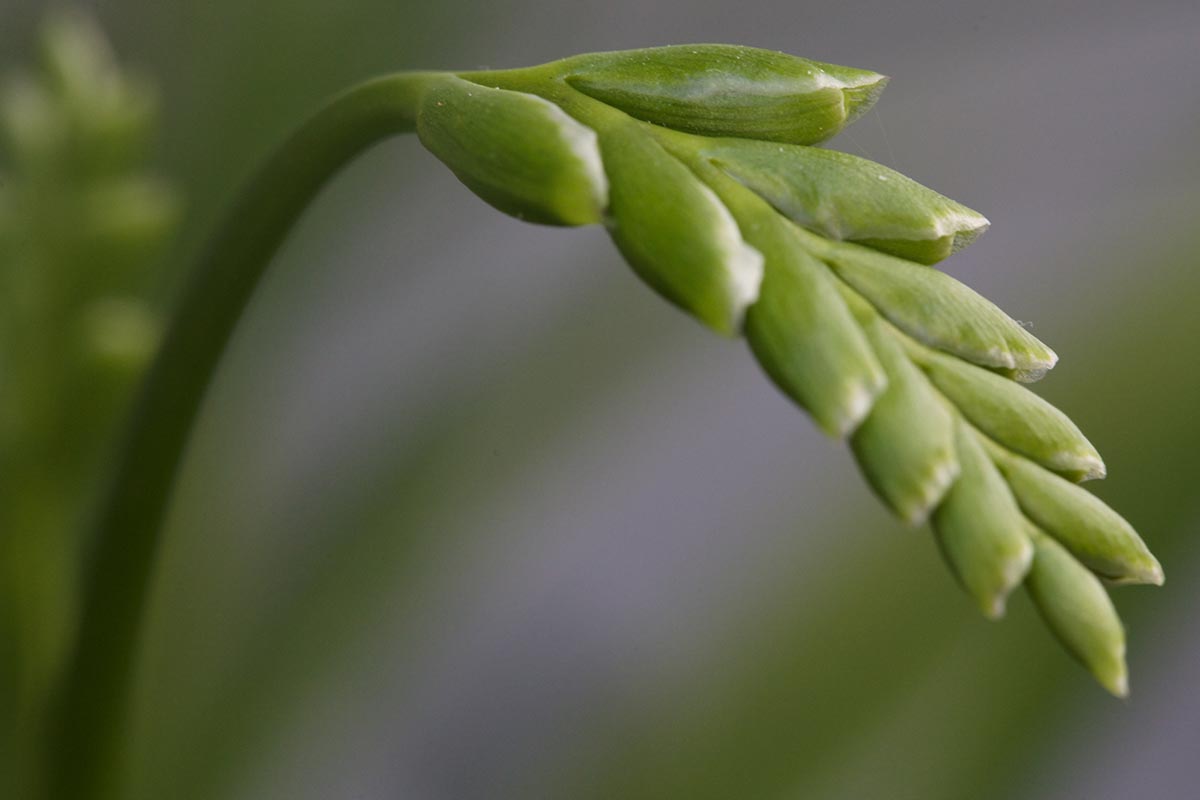
The foliage is grass- or sword-like, similar to that of a gladiolus or iris.
Flowers appear in succession along one side of a leafless, arching raceme and bloom from the bottom to the top.
The average mature dimensions are 12 to 18 inches tall and six to 12 inches wide.
Cultivation dates back to 19th century England during the heyday of plant hunters who discovered new species for British collections.
With six to 12 fragrant flowers per stem and longevity as a cut flower, these exciting species were destined for cutting gardens and florist shops.
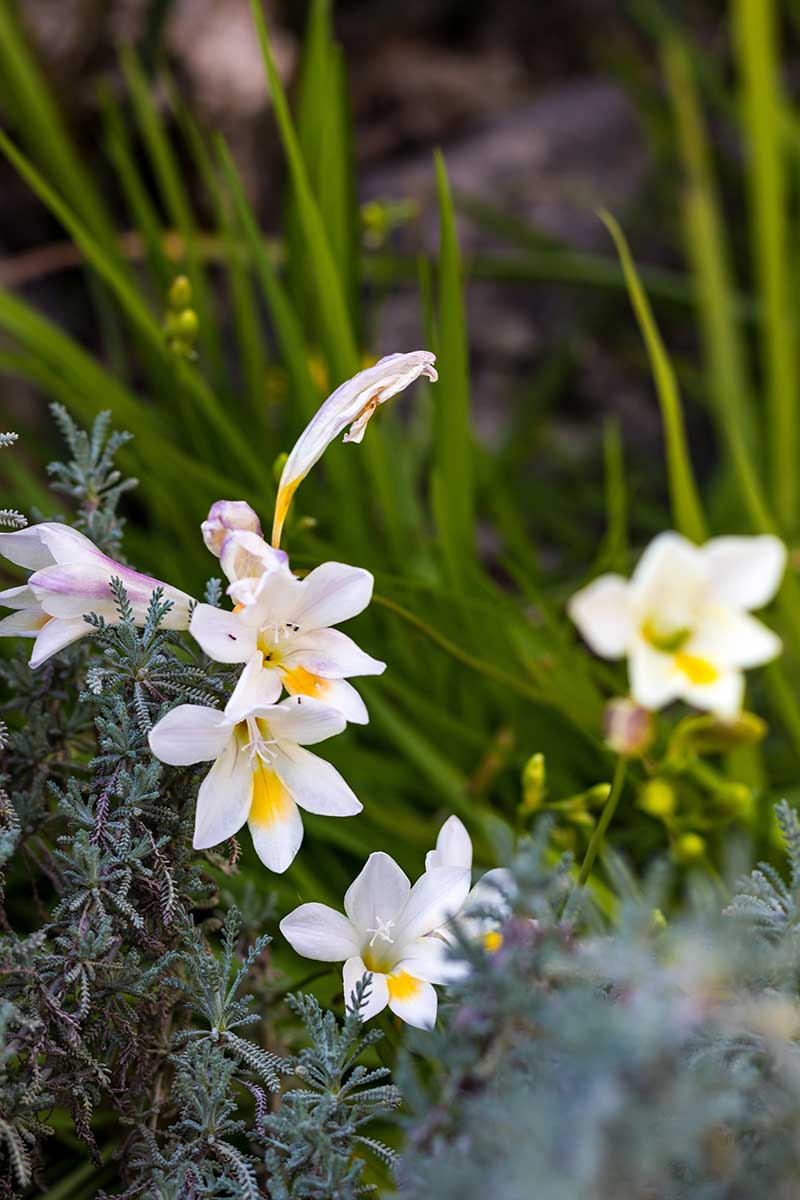
By the late 19th century, hybridization was underway in Europe.
The initial crossbreeding of species like the greenish-yellow, yellow, or white F. refracta and creamy F. leichtlinii, with its slight lavender tinge and yellow blush, opened the door to a booming floriculture.
Other species that would make their way into development include the highly fragrant, predominantly white F. alba, red and sometimes pink F. grandiflora, and “flowering grass,” F. laxa in various colors, including pink.
Today’s gardeners and floral designers have access to hybrids that date to the 1890s, when species within the Freesia genus were crossed to create new flowers with features like disease-resistance, double petals, and taller heights than their wild counterparts.
Unfortunately, some cultivated varieties’ sweet and heady fragrance was lost in the process.
Next, we’ll talk about how to start plants.
Freesia Propagation
In its native habitat, freesia multiplies by self-sowing seeds and/or growing offsets or “daughter” corms.
We can start new plants at home by buying corms, dividing existing clumps to obtain offsets, and sowing seeds. Let’s discuss.
By Division
We can also start new plants by division.
To divide, wait until the plants have finished blooming and the foliage is withering, then dig up the clump of corms.
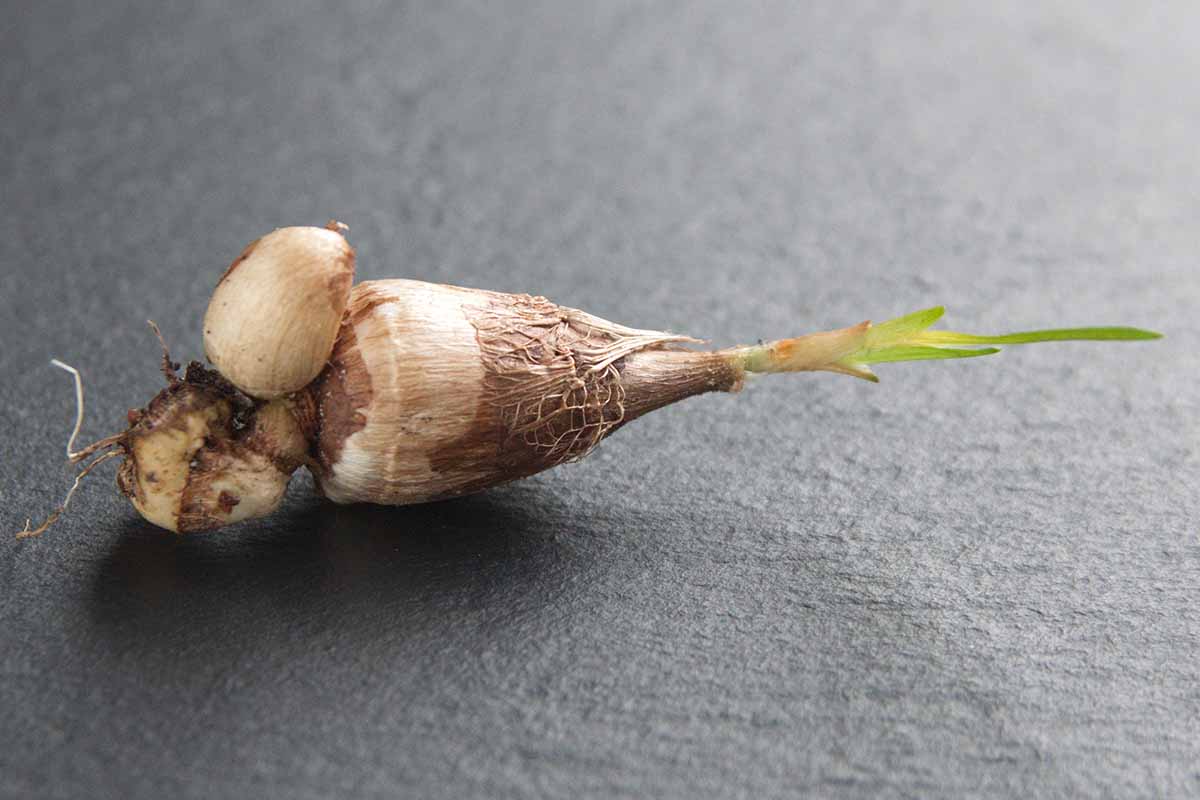
Separate and remove withered parent corms and retain the fresh, young offsets that grew up beside them to sow in containers or other locations.
From Seed
While corms are readily available and faster to sprout, you can also start with seeds.
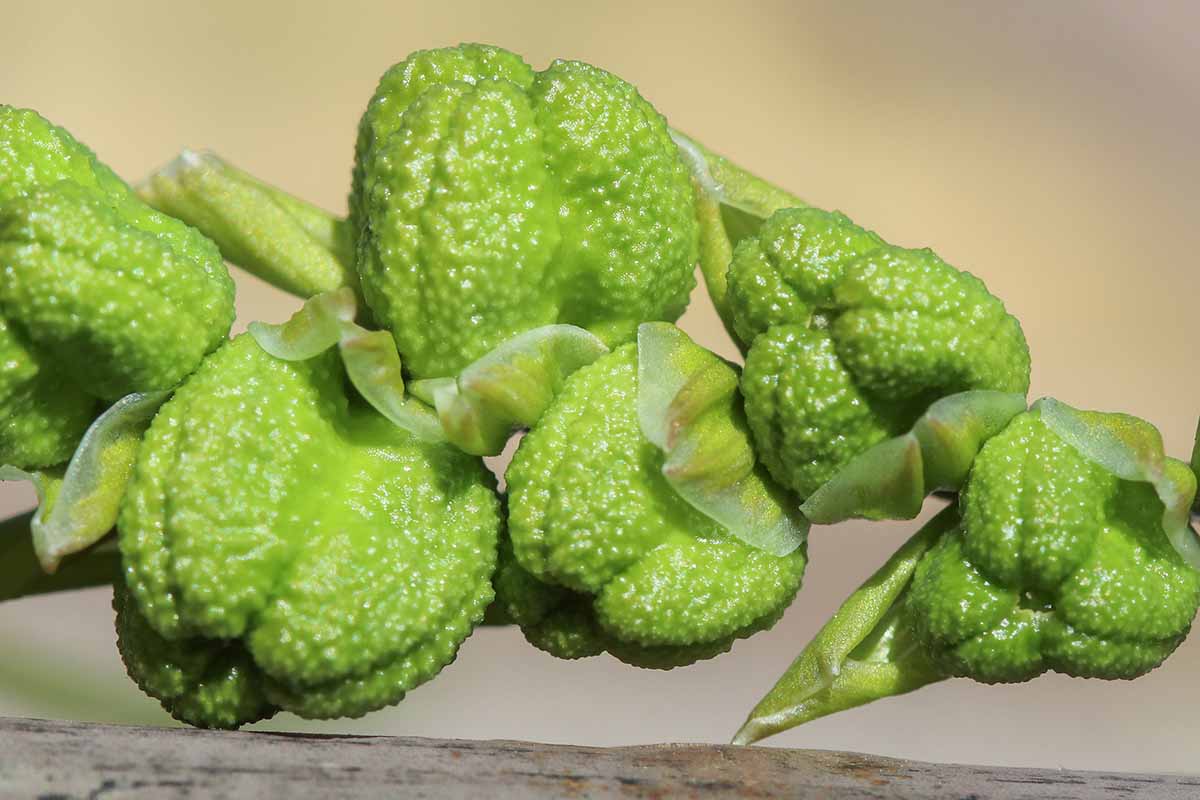
Some species, like F. laxa, self-sow, dropping seeds that help to ensure the species’ survival in the wild.
Hybrids don’t always produce viable seeds. When they do, the seeds don’t grow into clones of the parent but can vary in traits like color, form, and quality.
If you start plants this way, be sure to purchase seeds or collect them from a species plant, not a hybrid, after the green seed pods turn brown.
When you have your seeds, soak them in water for 24 hours.
Use biodegradable seed starter pots with two to three seeds in each.
Lightly cover the seeds with garden or potting soil.
Moisten the soil, but do not oversaturate it.
Sprout the seeds in darkness at 55 to 64°F for best results. You can cover the pots loosely with foil and use a heat mat to achieve these conditions.
Once they sprout, thin the seedlings to one per pot.
Maintain even moisture and a temperature between 41 and 50° F.
Allow six months for the seeds to germinate and one to two years for them to mature to corms that flower.
Transplanting
A corm, like a bulb, stores all of the nutrients a plant needs to thrive.
If you are growing in containers, they should be eight inches deep to accommodate freesia’s long taproot. In the garden, work the soil to a crumbly consistency to a similar depth.

Set the corms two to three inches apart, with the pointed end facing upwards, situated just above the surface of the soil.
Freesia corms purchased from garden centers or nurseries may be heat-treated or untreated.
Heat-treated corms are intended for planting in cool zones that experience freezing temperatures and frosts. Plant them in early spring for a late summer bloom, approximately 110 to 120 days later.
If you live in a zone that freezes, and don’t want to grow freesia as an annual or lift corms annually, you can also grow them indoors for winter flowering. Plant them in early fall for blooming in 10 to 12 weeks.
You can also pot up corms to grow in a cool greenhouse in areas that freeze, for a cutting garden through the winter. The ideal temperature is 41 to 50°F.
Untreated corms are suitable for warm zones. They should be planted in late summer for spring flowers the following year.
Once we have our plants it’s time to address cultural requirements.
How to Grow Freesia
Freesia needs full sun to flower abundantly, though it will tolerate part shade locations, particularly in hot climates.
The soil should be organically-rich, sandy loam that drains well, with a slightly acidic to neutral pH of 6.5 to 7.0.
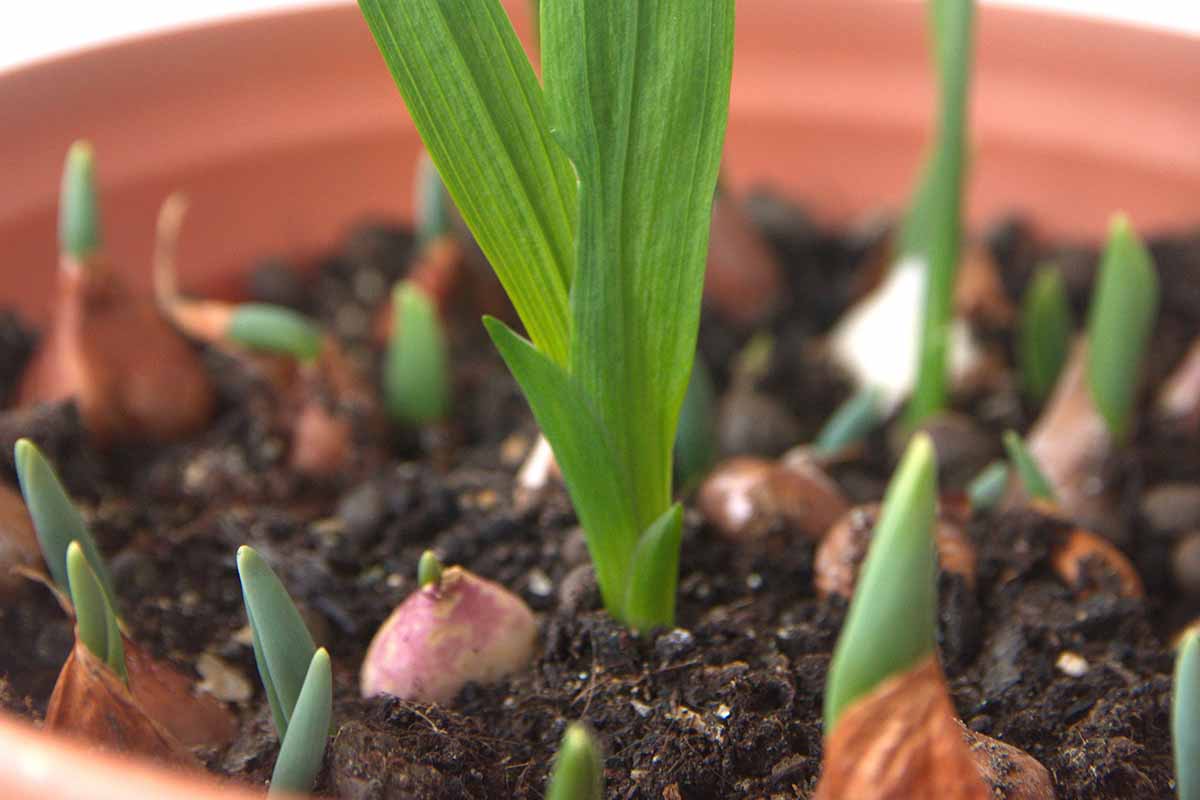
If you garden in containers, choose a quality potting soil that is light, airy, and moisture retentive.
Two to three-inch spacing creates a swath of color and enables plants to support each other.
However, it may increase the risk of fungal disease in wet climates due to the buildup of moisture and humidity.
If excess moisture is an issue, you can space your plants more loosely and install circular supports at planting time to avoid floppy stems.

Half-Round Plant Support Rings
These support rings are half-circles made of durable, weather-resistant green plastic that blends well with green garden foliage.
Place them around bulb groupings for the duration of the growing season and reuse them again the following year.
Half-Round Plant Support Rings are available from Zotuk via Amazon.
Provide minimal moisture while you wait for the corms to sprout. Once sprouts appear, maintain even moisture but do not oversaturate the soil.
When buds form, fertilize bimonthly with an all-purpose, potassium-rich liquid product, like one formulated for tomato plants.
Avoid fluoridated water and fertilizers that contain phosphorus fluoride, as freesia reacts adversely to these chemicals.
After an entire stem finishes blooming, you may snip it off near the base or allow pods to form and self-sowing to occur. Remember that seeds from hybrids will not produce true to the parent plant, so you may not want them to go to seed unless you’re curious about the possible results.
Once all of the flowers finish blooming, discontinue fertilizing and watering.
If you are growing perennials or lifting corms at season’s end to store them, allow the leaves to remain in place to feed the corm for next year’s flowers.
If you are growing annuals to discard post-bloom, remove them entirely to the compost heap when the flowers finish. Always clear all debris to avoid harboring pests and pathogens.
Growing Tips
With the best cultural practices, freesia thrives and delights with a spectacular display. Support its health and beauty by remembering to:
- Use the appropriate type of corm for your growing region.
- Provide a location with full sun.
- Use organically-rich, sandy loam or potting soil that retains adequate moisture while draining well.
- Sow corms at appropriate distances to self-support in dry regions and maintain airflow in wet conditions.
- Install support structures at planting time as needed.
- Maintain even moisture without oversaturation during the growing season.
- Fertilize bimonthly with a potassium-rich liquid product once buds appear.
- Stop fertilizing and watering when blooming finishes.
- Lift and store corms to reuse.
Now we’ll move on to maintenance.
Maintenance
If you live in a warm zone and enjoy growing freesia as perennials, maintenance includes digging and dividing corms, relocating divided offsets, and removing withered foliage at season’s end.
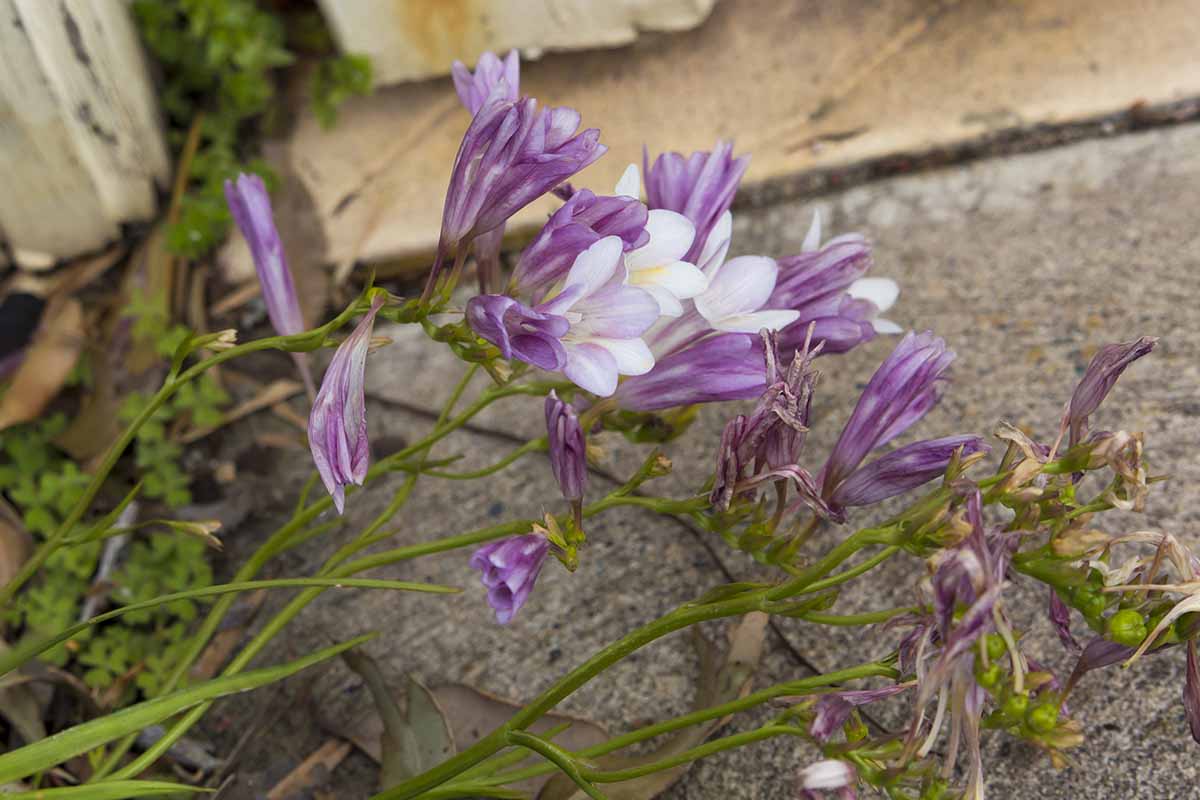
After blooming in the spring, you may want to lift and store to avoid rotting during rainy spells.
Here’s how:
- When the flowers fade, allow the foliage to wither.
- Dig straight down about 10 inches and lift clumps of corms.
- Remove the withered foliage and brush off the soil.
- If you want to divide offsets from the parent corms, do so now.
- Lay out the corms you wish to store on newspaper in a single layer, making sure they are not touching.
- Inspect the corms for signs of disease, and discard any that are discolored and/or soft.
- Dust the remaining ones with a fungicidal powder if desired.
Per the Royal Horticultural Society, store the corms in a paper bag in an 80°F location with high humidity of about 75 to 80 percent for 14 to 20 weeks.
Note that with higher heat and moisture, corms are susceptible to fungal disease, so inspect them regularly and dispose of any that are affected.
Be sure to label the bags, especially if you have different varieties.
Conversely, if you are gardening in a zone that freezes, lift the corms to store them after they wither and before the first frost.
Here’s how:
- Dig up the corms when all of the foliage finishes feeding the bulb and turns brown.
- If you want to separate offsets from the parent, now’s the time.
- Lay the corms on a tarp or newspaper in a single layer with space between them.
- Place them in a cool, dry location out of direct sunlight to cure for two to three weeks.
- When they are dry, dust with fungicide if desired.
Store the corms in labeled paper bags in a cool, dry location between 35 and 40°F.
Freesia Cultivars to Select
There are numerous types of this widely hybridized floriculture star available. Here are some to whet your appetite:
Double Mix
Freesia x hybrida Double Mix boasts double blossoms that hint of mint, honey, and citrus, and display assorted bright colors.
Sow in the fall for perennial cultivation in Zones 8 to 11. Plant in the spring as an annual in Zones 2 to 7.
Plants mature to heights of 12 to 16 inches.
Double Mix freesia is available from Eden Brothers.
Single Red
Freesia corymbosa ‘Single Red’ has vibrant red blossoms, rich yellow throats, and a peppery perfume.
Plant in autumn in Zones 8 to 10 or in the spring in Zones 1 to 11. Expect mature heights of 15 to 20 inches.
‘Single Red’ is available from Nature Hills Nursery.
Single Yellow
Freesia corymbosa ‘Single Yellow’ is a buttercup yellow beauty that emits a fresh spring scent as it basks in full sun.
Sow it in the fall in Zones 8 to 10 and in the spring in other temperate zones. Plants mature to heights of 12 to 16 inches.
‘Single Yellow’ freesia is available from Nature Hills Nursery.
Managing Pests and Disease
With quality corms from a reputable purveyor and best cultural practices, you are unlikely to experience problems.
However, there are a variety of pests and diseases to be aware of.
Pests
Pests to be aware of include, night-feeding slugs and snails, and sapsucking aphids and thrips.
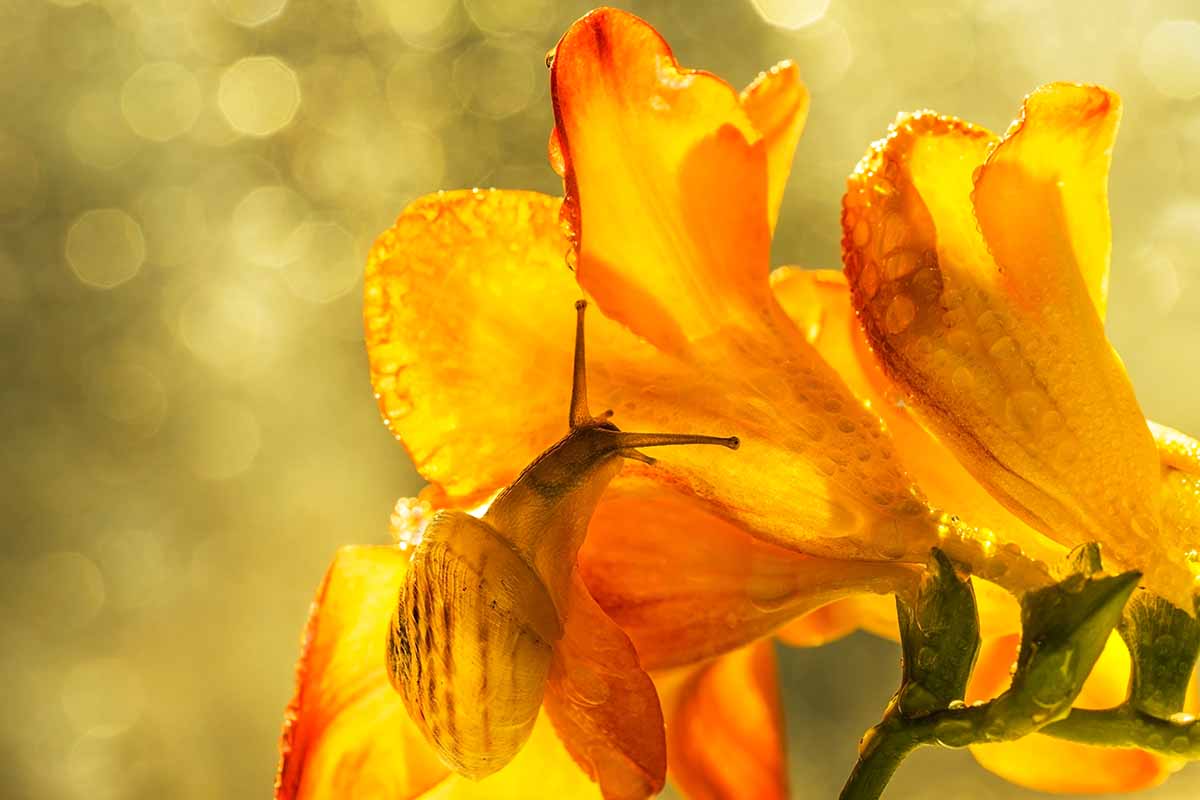
If you find the leaves chewed off, it’s likely slugs and snails have feasted upon them during wet weather or overwatering.
Tell-tale signs of sapsuckers are leaf distortion, discoloration, and desiccation, followed by leaf drop and a failure to thrive.
These pests are often disease vectors that cause extensive damage when infestations go unchecked.
In addition, herbivores like moles and voles may feed upon bulbs under the soil. Screening bulbs with a mesh enclosure at planting time is a preventative measure to consider.
Disease
Diseases to watch for include:
Gray Mold
Gray mold, caused by Botrytis cinerea, occurs with high humidity and appears as a gray fuzz on foliage, flowers, and buds. Black stiff or “sclerotic” structures may be visible.
Damaged plants are most vulnerable to softening, decay, and death.
As there are no effective treatments, growers should take avoidance measures, like sanitary practices, the reduction of humidity, and the removal of damaged or decaying plant material.
Iris Leaf Spot
Mycosphaerella (syn. Didymellina) macrospora fungus causes iris leaf spot. It may affect the foliage or buds and first appears as rounded, yellowish lesions.
The lesions dry, and the desiccated patches enlarge until the leaves turn brown and curl up. Premature leaf death results in a failure to nourish the corms for next year’s flowers.
Proactive measures to avoid iris leaf spot include:
- Growing in full sunshine
- Using organically-rich, well-draining soil that is not overly acidic
- Avoiding low-lying landscape areas with poor airflow
Destroy all affected foliage and treat remaining flora with a spray-on fungicide.
Viruses
Freesia Mosaic Virus (FreesiaMV) spreads via the potato aphid, Macrosiphum euphoribae, and the green peach aphid, Myzus persicae.
Freesia Sneak Virus (FreSV) is the result of a soil borne fungus, Olpidium brassicae, and is associated with the little understood Freesia Leaf Necrosis Disease (FLN).
Common viral symptoms are the development of yellow or “chlorotic” spots that spread, merge, dry, wither, and lead to overall decline and death.
Unfortunately, plant viruses are not treatable. Their presence requires the removal of affected flora, sanitization of tools, and rotation to a new location next year.
Best Uses for Freesia Flowers
Showcase fragrant freesia in cottage garden beds among the cosmos, dahlias, geraniums, and ranunculus.
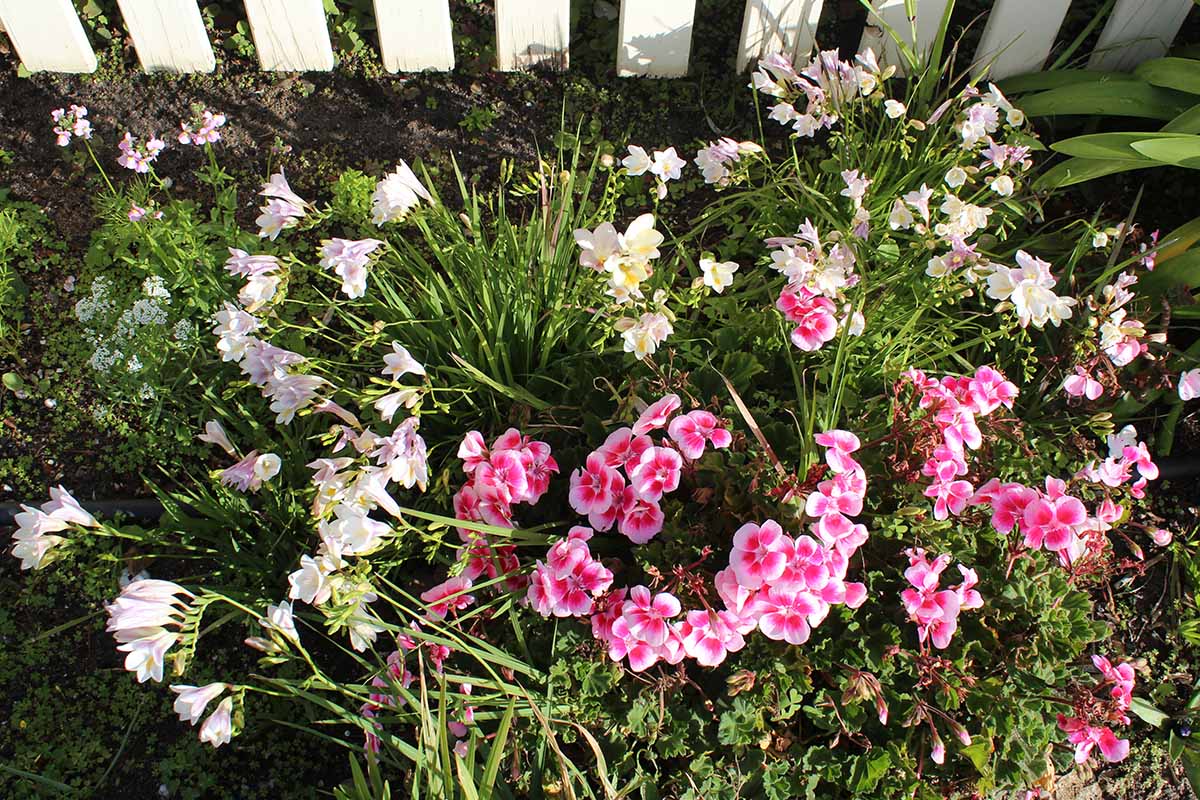
Pair it with sweet alyssum in sunny borders and containers for fragrant variations in height and form.

Fill a section of your cutting garden with masses of cheerful stems for bouquets and vase arrangements.

Scatter bulbs for a naturalistic display that will enlarge over the years.
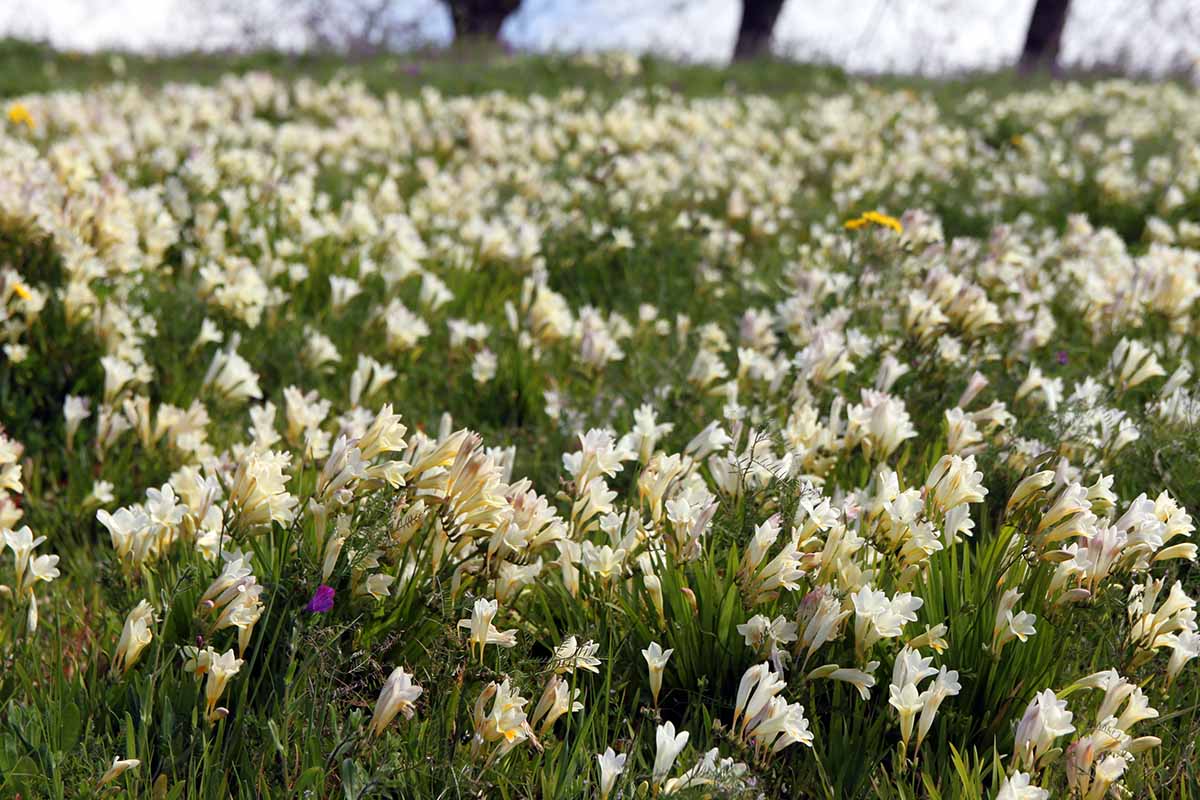
Interplant freesia with gladiolus and iris. Their comparable heights and sword-like foliage provide continuity punctuated by diverse and eye-catching blooms.
Quick Reference Growing Guide
| Plant Type: | Tender herbaceous perennial | Flower/Foliage Color: | Bicolor, lavender, orange, pink, purple, red, white, yellow/green |
| Native to: | South Africa | Tolerance: | Some shade |
| Hardiness (USDA Zone): | 9-10 | Maintenance: | Moderate |
| Bloom Time: | Mid-winter-spring (perennials), late summer (annuals) | Soil Type: | Organically-rich, sandy loam |
| Exposure: | Full sun-part shade | Soil pH: | 6.5-7.0 |
| Time to Maturity: | 110-120 days | Soil Drainage: | Well-draining |
| Spacing: | 2-3 inches | Attracts: | Honey bees |
| Planting Depth: | Tip of corm above soil level | Companion Planting: | Cosmos, dahlia, geranium, gladiolus, iris, ranunculus, sweet alyssum |
| Height: | 12-18 inches | Uses: | Annual, beds, borders, containers, cottage garden, cutting garden, naturalized plantings |
| Spread: | 6-12 inches | Family: | Iridaceae |
| Water Needs: | Moderate | Genus: | Freesia |
| Common Pests and Diseases: | Aphids, slugs, snails, thrips; gray mold, iris leaf spot, viruses | Species: | Alba, armstrongii, grandiflora, laxa, refracta |
Fabulous, Fragrant Freesia
Whether you grow it as a perennial or an annual, freesia is sure to charm.
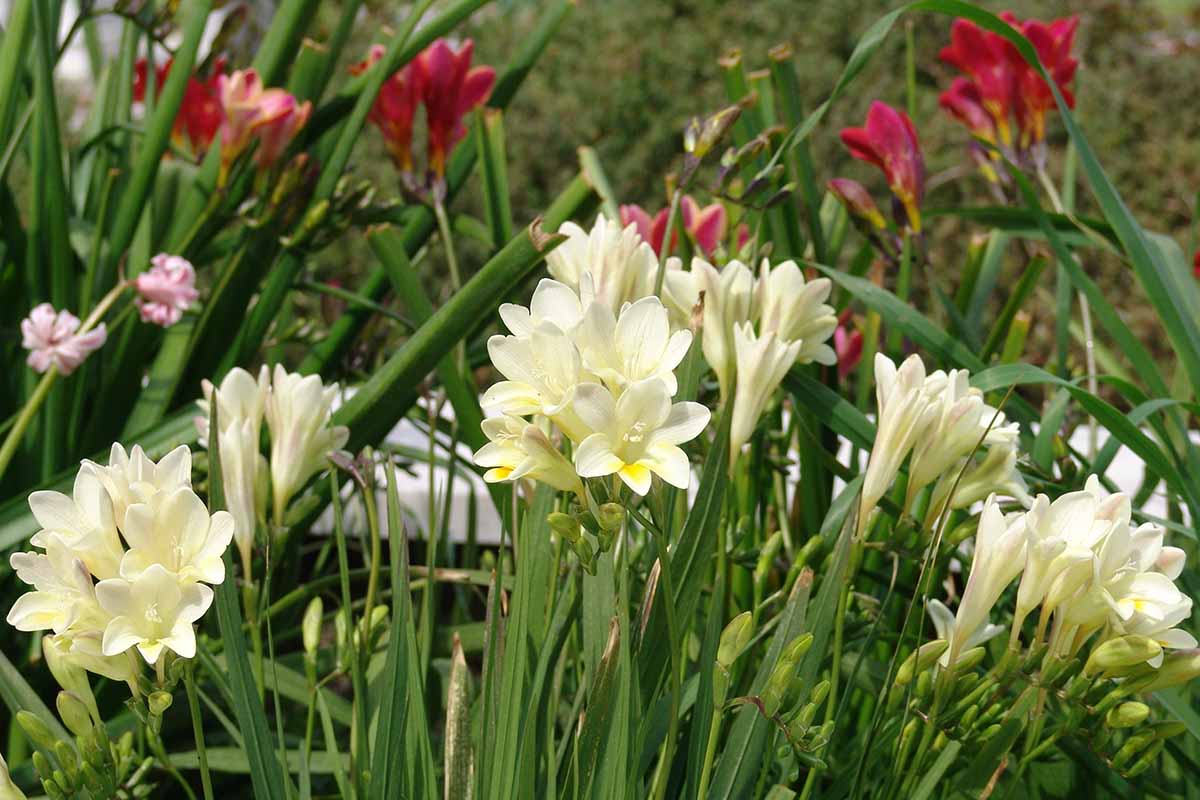
For container gardening, remember to use a high quality potting medium that is light and well-draining.
In the garden, grow in organically-rich, sandy loam that is slightly acidic and drains well. Avoid overwatering to prevent the corms from rotting, and lift them in locales that freeze in the winter.
The slender, arching racemes may have a delicate appearance, but freesia is sturdy enough to last up to three weeks in a vase, provided you give the stems a fresh cut and change the water daily.
It’s time to add freesia to your garden planner today for a robust display of fabulous, fragrant seasonal blooms.
Do you grow freesia? Have you any tips to share in the comments section below?
If you found this article informative and want to read about other frost-tender flowering perennials often cultivated as annuals, we recommend the following guides next:

